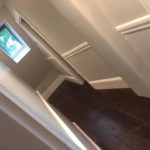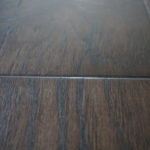Caring for Shaw Epic PLUS Hardwood Flooring
Caring for Shaw Epic PLUS Hardwood Flooring

We’ve used pre-finished flooring, like Shaw Epic PLUS, on projects in the past. Most recently on a third floor renovation. Read more about the hardwood flooring selection process here. Pre-finished or engineered flooring is not the same as traditional wood flooring, so after the installation, we are often asked what are the differences in regards to maintenance. In this article we’ll discuss caring for Shaw Epic PLUS Hardwood Flooring.
Long term care of a product like this looks very different from traditional hardwood floors. Typically once an unfinished floor goes down, you can refinish it as many as 5 or 6 times, if not more. With a prefinished product the veneer is not something you will want to sand. Plus, the ScufResist Platinum finish on Shaw’s Epic Plus hardwood provides a level of protection that would make it very difficult to sand evenly.

We’ll go into detail on what expectations you’ll want to communicate to your client, A LOT of detail, but considering you can’t just sand your problems away these considerations are important. Sure boards can be replaced as needed for serious damage, but uniform wear and tear leaves the homeowner with no other option besides a replacement floor. Although refinishing your floor isn’t always the best option out there.
According to OSHA, “Wood dust becomes a potential health problem when wood particles from processes such as sanding and cutting become airborne. Breathing these particles may cause allergic respiratory symptoms, mucous and non-allergic respiratory symptoms, and cancer.”
Conditioning the Flooring
Proper installation of hardwood flooring is the first step in ensuring your new hardwood floor will last. Well actually, that is the second step. The first step is conditioning the flooring to your space. If the material was in extreme heat or extreme cold in transit you’ll want to give it time to adjust to room temperature. Additionally, you’ll want the material to acclimate to the humidity level of your home, ideally between 35% and 55% humidity.

This is a critical step to prevent call backs whether you install the hardwood floor or it is subcontracted out to a flooring specialist. Coordinate flooring delivery in advance of installation by at least one day. It may be tempting to start right away, especially with a homeowner anxious for the project’s completion, but although time is money, call backs always hurt the bottom line, in addition to your reputation.
It is common to confuse the effects of moisture and temperature on wood. Temperature only has an impact at very high levels, while even moderate amounts of moisture can hurt a wood floor.
So back to the second step, proper installation. Refer to Shaw’s webpage for installing hardwood floors and product specific instructions. I especially want to call out the importance of expansion space against walls and cabinets. Lack of adequate expansion space can be a big problem with any hardwood installation, and it’s a problem you can easily avoid.
Preventative Care
Ensuring your hardwood flooring is acclimated to temperature and humidity is key before install. Likewise, keeping a consistent temperature and humidity level in your home is an important part of preventative care. If your space becomes too dry, typically in cold weather, when you’ll also be heating your home, boards may shrink. Conversely, in warmer weather, humidity levels rise which in excess can cause swelling of floor boards.

As a contractor you should know the environment your dealing with. If an old furnace supports the conditioned space or the home lacks A/C, think about the changes in humidity and temperature the floor will be exposed to. Suggest installation methods and products accordingly. And more importantly use this information to recommend appropriate warnings to your client and ensure they know the trade-offs of their flooring selection.
Swelling can cause buckling and loosen boards from the subfloor. This cycling of shrinking and expanding will wreak havoc on your flooring. Preventative care for humidity include using a humidifier in winter. And during the humid summer months, running your air conditioner or a de-humidifier. Regardless of the season you’ll want to maintain a 35-55% humidity level. Again the intent is to prevent excessive swelling or shrinking of the material.

Here is where engineered flooring shines in my opinion as a contractor. Typical engineered floors are often composed of MDO or MDF type materials, which by nature are much more stable than actual ¾” medium hardwoods, like oak. Shaw’s Epic Plus hardwood with Stabilitek is actually an HDF core. These products can withstand greater changes in humidity and temperature than actual wood, which means less shrinking or swelling. Most importantly, the floor will look more like the day it was installed several months down the road. Less call backs!
Wear and Tear
You want to ensure you don’t expose your flooring to unnecessary stress. It goes without saying! Avoid walking on the floor with spiked athletic shoes, damaged heels, and be weary of rocks stuck in shoe soles. Pets with untrimmed nails can scratch flooring also. Be sure to protect flooring when moving heavy objects. Distribute weight on objects that put point loads on the floor.

Less obvious stresses can be from direct sunlight, some species of wood will fade after prolonged sun exposure. Its good practice to limit direct sunlight when able and if using rugs, to move them periodically, to ensure the aging of the wood is even. Do the same with furniture.
This laundry list may seem excessive. But you can’t over-communicate expectations to your clients. Shaw Epic PLUS with Stabilitek is a great product but like every material it has it’s limitations. You shouldn’t let your customers think any product is indestructible.
Routine Care
Routine care consists of addressing spills and regular cleaning to remove dust, dirt, sand, and other debris. To prevent excessive debris from getting to the floor surface, use entry mats to collect dirt before it gets to the floor, or you can institute a no shoe policy. Either way you’ll have to do some routine care to keep your floors looking great because despite any in home policy, you can’t avoid spills.
Dealing with spills is probably the most common form of routine care you’ll face. Going back to our humidity conversation, standing moisture on your floor can cause extreme swelling or discoloration. Use an absorbent towel to blot and soak up spills as soon as they occur. Avoid wiping spills across multiple boards, this allows moisture to seep between the seams of the boards.

Routine care will primarily be cleaning. Sweep, dust, or vacuum your floors using appropriate products. Specifically, if vacuuming, use a hard floor attachments as beater bars designed for rugs or carpeting can dull your floor’s finish. Once clean, Shaw recommends using R2X Hard Surfaces Flooring Cleaner, to remove dirt without damaging the floors finish.
Caring for Shaw Epic PLUS has some differences from traditional hardwood flooring. The major difference being refinishing options. Ultimately, when these considerations are taken into account, this flooring is easy to care for and easy to maintain.
Installing A Shaw Epic PLUS Engineered Hardwood Floor Video Review
Installing Shaw Epic PLUS Hardwood Flooring
This is a sponsored conversation written by me on behalf of Shaw Floors. The opinions and text are all mine.















